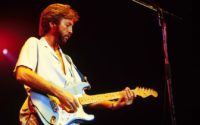WHY JEFFERSON AIRPLANE’S REUNION CRASH LANDED
The summer of 1989 was already shaping up as the Second Coming of Dinosaur Rock. The Who’s first post-retirement shows were underway. Paul McCartney was preparing for his first major tour in a decade.
The Doobie Brothers had a comeback album out; a new project from the recently reformed Rolling Stones was on the way. Lynyrd Skynyrd and the Allman Brothers Band were together again, too.
Then came the most surprising thing of all: A Jefferson Airplane reunion. After all of that time apart? After all of those career twists and turns? And all that had been said and done?
“We each went our own ways, sort of [angry] at each other,” co-founder Paul Kantner told the Los Angeles Times in 1988. “But it’s like in a family. Very few doors and bridges burn with these people. Things come around.”
It took a while, though, and a lot happened in the meantime: The original group had released a series of era-defining anti-establishment projects in the late ’60s before morphing into Jefferson Starship, a far less political outfit. Jefferson Airplane guitarist Jorma Kaukonen and bassist Jack Casady ultimately decided to focus on Hot Tuna, an offshoot band they formed in 1970. Singer Marty Balin eventually went solo.
Kantner called these departures a “radical disappointment. It was like a family breaking up, or a romance,” he told the Times. “I felt a sort of personal failure. I hold on to the bitter end in any relationship.”
Unfortunately, the marriage at the heart of the band between Kantner and Grace Slick fell apart, too. They’d divorced in 1975, then split professionally in 1984. Kantner subsequently took his ex-bandmates to court over rights to the band name and for back royalties.
Perhaps understandably, the late Balin was initially reluctant to return. “Let’s face it, every time I read about them,” he told the Chicago Tribune in 1989, “they’re always suing each other.”
The original Jefferson Airplane was piloted by Balin, who put their first lineup together in 1965 to serve as house band for his nightclub. Initial auditions also led to hiring drummer Skip Spence, and singer Signe Anderson. Slick replaced the late Anderson for their second album, and Jefferson Airplane took off on the strength of “Somebody to Love” and “White Rabbit,” a pair of songs she brought along.
Balin quit as Jefferson Airplane morphed into Jefferson Starship, then returned in time to guide the updated band to its biggest hit, “Miracles.” Jefferson Starship continued along that line, shedding founding members and becoming more and more chart oriented. By then, basically everybody was suing everybody. Kantner won a judgment forcing his former group to stop using “Jefferson” in the name, but they kept stacking up pop hits.

“I occasionally meet people who think I was in Starship,” Kaukonen later told the Orlando Sentinel, with a laugh. “I say, ‘No, no, you got it all wrong; you can’t blame me for that.'”
A few years later, Kantner, Balin and Casady formed a short-lived splinter group called the KBC Band, and seeds for a larger reunion were inadvertently planted. Then Slick made a guest appearance during a 1988 performance by Hot Tuna at the Fillmore in San Francisco. Kantner was there, too.
“It started out as a joke on Paul,” Slick told the New York Times in 1989. “We hadn’t even talked for a year, and we were battling legally – in fact, there are still some standing lawsuits between me and Paul, something to do with the Airplane. But then, there are at least 15 or 20 active lawsuits now between managers, record companies, agencies, a morass of stuff that comes from all different angles. Anyway, the idea was that I’d just sneak in, stand at the side of the stage and come out and sing ‘White Rabbit’ and see what Paul did. Paul never got the joke, but he liked it, the audience liked it – and that’s how it started.”
Balin eventually came on board – at that point, he was without a recording contract and touring small clubs – but the late Spencer Dryden, the drummer who replaced Spence into Jefferson Airplane’s classic era, did not. The New York Times said he declined to come out of retirement. Journeyman Kenny Aronoff took his place.
“I think we had all thought about reorganizing the Airplane in the last few years,” Kantner told the Associated Press in 1989. “Grace came out to sing at that show and we all felt very good. Jorma and Jack seemed to like the idea of us all working together again, and we’d all written new songs and wanted to perform them.”

In fact, creating new music was critical to their comeback, as Jefferson Airplane distanced themselves from other classic-rock mega tours of the day. They were playing smaller, more intimate venues, and they weren’t simply trotting out the old hits. A self-titled comeback album was set to arrive that August.
“The idea that we’re cashing in is ridiculous,” Slick told the Times. “We’re not the Who or the Rolling Stones: We’ve never made $60 million on anything, although people think we’re rolling around in money because they know our name. With this tour, we’re hoping that we break even and maybe make a little. The audiences are very receptive, but it’s not Yankee Stadium.”
In a nod to the era, Jefferson Airplane made their first music video for the Kantner-penned single “Planes,” which rose to the No. 24 on Billboard’s Mainstream Rock chart. Like “Summer of Love,” the Balin song that served as an advance single, “Planes” had its roots in the KBC Band. Kaukonen’s “Ice Age” and “Too Many Years” were developed out of previous solo ideas, too. Slick rounded things out with four new tracks.
While the reunion tour was generally well received, however, the same couldn’t be said for Jefferson Airplane, which stalled out at a paltry No. 85 on the Billboard charts. Ironically, their desire to remain creative in the studio ended up tearing the group apart again.

Jefferson Airplane was produced by Ron Nevison, who’d earlier worked on sleeker, turn-of-the-’80s fare from Jefferson Starship – as well as Software, Slick’s 1984 solo album. That feel carried over to this reunion project, which found members of Toto sitting in on the Balin-sung “True Love.”
An already restless Kaukonen bristled at the more modern approach, saying it “was not the way we used to do it in the old days. It was very much the modular, sequenced L.A. way of recording,” he told the Orlando Sentinel in 1991. “It works for some people but not me. It just wasn’t even fun. It was well done but not very passionate.”
By then, he’d already returned full time to Hot Tuna. Slick had suggested that the offshoot band play part of the set during Jefferson Airplane’s reunion show, sparking interest from Epic Records executives who attended a stop at Radio City Music Hall. Hot Tuna got a new deal and quickly released 1990’s Pair a Dice, their first new studio album in 14 years. Jefferson Airplane was no more.


